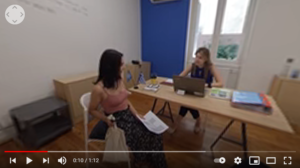Logistic

THEORETICAL FRAMEWORK
GOALS:
General:
-
To familiarise Greek local community with immigrants culture
-
To make the local community more sensitive to the needs of other cultures
-
To build intercultural competences
Goals` taxonomy according to Bloom
A) Cognitive goals:
-
to address a specific situation by using VR movie
-
to understand the situation of immigrants in Greek local communities deeper by total immersion in a semi-real situation
-
to learn about immigrants culture
B) Emotional goals:
-
to ensure emotional security in terms of welcoming New/Different/Other cultures and its representatives to the local community
-
to immerse participants in a semi-real situation and connect it with personal experiences and emotions
C) Psychomotor goals:
- to deal with particular aspects of the behaviour related to the situation of immigrants using public services and offices
- a deeper understanding of the situation of immigrants (as applicants) while using different public services and offices
- building intercultural competencies ready to use in a situation of welcoming immigrants in public services and offices
- building sense of security in situations related to the topic
discussion, VR movies, drama, working sheets, active learning methods
Trajectory of the teaching process
The following teaching session aims to introduce the Greek local community to immigrants culture and immigrants needs. During the session, participants will experience and practice different situations related to public services and offices. Throughout VR movies they will immerse into a Greek Law office and meet immigrant as an applicant.
Warm up game: “Name Card” activity.
Presenter shows card with his/hers name written and tells the story about his/ her name by answering the questions:
1) What colour is you name?
2) What is a sound of your name?
3) What meaning has your name?
4) What is a symbol of your name?
Presenter hands to each participant colorful card (A5 format) and asks to create their own card name – also by answering the previous questions. After 10 minutes participants share their stories and present their cards.
| Activity Title | Activity Description |
|---|---|
| Before video watching | Brain storm Presenter asks participants to tell their first associations with public services and offices that immigrants may need to visit. Presenter writes down all the answers on the white board and starts discussion on the ways that participants and immigrants use the services and facilities - group discusses differences and similarities. Presenter explains misunderstandings and wrong thinking. Presenter may also address short presentation and comments on immigrants culture. |
| Video watching | Watching the VR movie “Dealing with legal documents” (A, B and C) does not need any preparatory tasks. However, presenter should make sure all participants understand basics of legal system in Greece. Presenter divides group into 4 teams. Each team watches different video: After watching the video presenter encourages participants to share their experience and emotions in the forum. |
| After watching the video | Finding a solution Participants stay in teams. Presenter organises separate space for work. Each group sits into the circle. Presenter delivers to each group tasks linked to the vidoe as follows: After finishing this task presenter asks to discuss the obstacle and ideas in the forum. Teams share their solutions. |
| After watching video | Survival language/ handy dictionary Participants share their thoughts within the group and write it down. After 15 minutes presenter asks groups to present their work in the forum. Participants try to collect best ideas that appeared during the discussion and write them down. |
Sum Up
Presenter sums up what the group has discussed and learnt during the session. It is time for free questions, too.